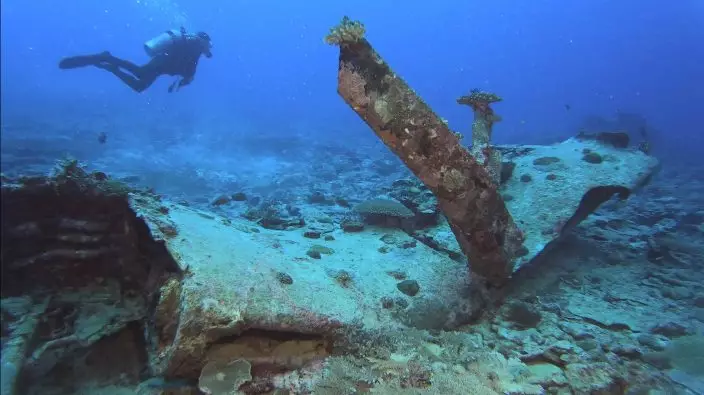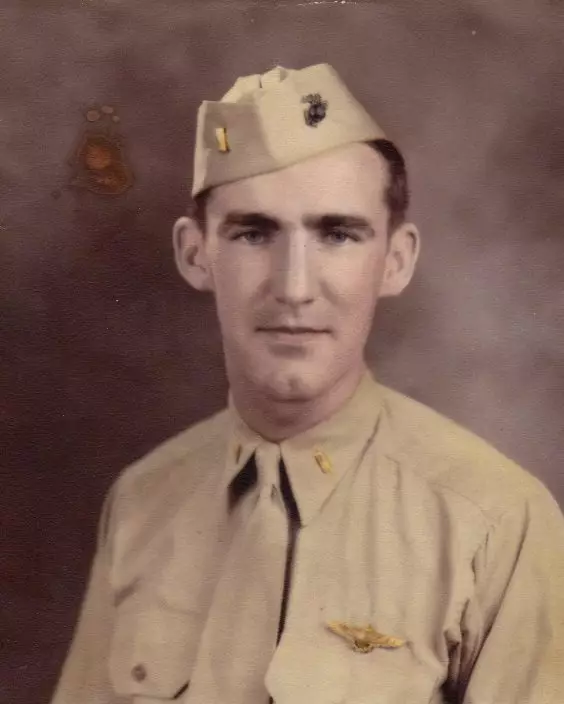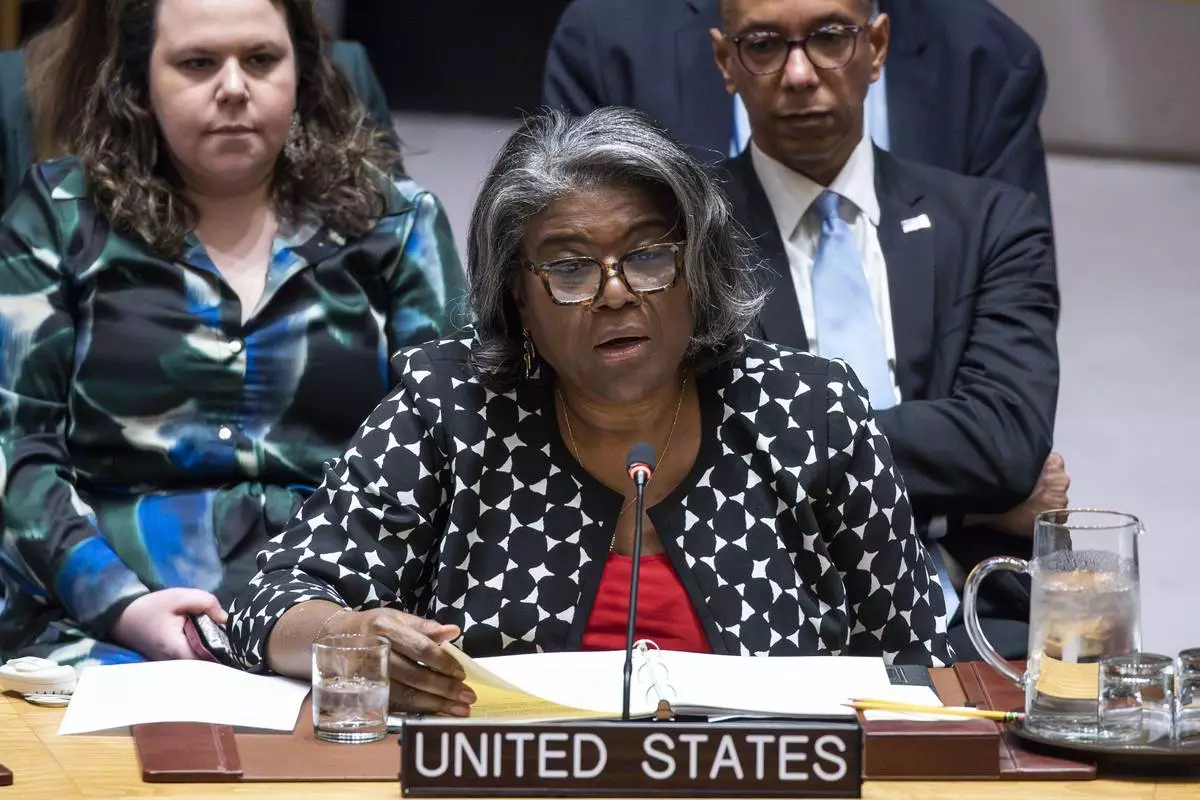Wreckage on the ocean floor near a Japanese island must be from a fighter-bomber that crashed in 1945 with an American pilot who is still listed as missing in action, according to a World War II researcher who recently visited the crash site.
The aircraft, lying on coral reef about 70 feet (21) meters down, is the same type of F4U-4 Corsair that 2nd Lt. John McGrath was flying when he crashed off Iriomote Jima in July 1945, researcher Justin Taylan said this week.
"This is the only American aircraft lost at that precise spot," said Taylan, the founder of Pacific Wrecks, an organization that researches and catalogues WWII crashes.

In this March 24, 2019 photo provided by Justin Taylan of PacificWrecks.com, a scuba diver swims near the left wing wreckage of an F4U-4 Corsair fighter aircraft off Sonai, Iriomote Jima, in Japan. World War II researcher Justin Taylan says the airplane wreckage on the ocean floor near Okinawa is from the fighter-bomber flown by John McGrath, a U.S. pilot from New York who's still listed as missing in action. (Justin Taylan via AP)
McGrath, of Troy, New York, is still officially listed by the U.S. military as one of nearly 73,000 American MIAs from WWII. He was 20 when his aircraft disappeared.
Taylan explored the wreckage during a scuba dive in March, along with a Japanese man who discovered the wreck in 1987.
Both wings, the engine and other parts lie approximately 300 yards (275 meters) from shore, a location where American pilots said they saw the plane go down.

This March 23, 2019 photo provided by Justin Taylan of PacificWrecks.com shows an aerial view of Sonai, Iriomote Jima, Japan. Taylan says airplane wreckage on the ocean floor near the island is from the fighter-bomber flown by 2nd Lt. John McGrath, a U.S. Marine Corps pilot from New York who's still listed as missing in action. (Justin Taylan via AP)
Although no identifying markings are visible after 74 years in sea water, the coral-encrusted wreckage clearly is from the newer version of the Corsair that McGrath's Marine Corps aviation unit was flying at the end of the war, Taylan said.
Taylan, a former Pentagon contractor hired to research and find WWII crash sites in Papua New Guinea, became interested in McGrath's story in 2017, when he was contacted by the son of one of the missing pilot's old high school classmates.
After researching U.S. military records, Taylan enlisted the help of Kuentai, a Japanese group that searches WWII battlefields in the Pacific for the remains of Japanese and American servicemen.

In this March 22, 2019 photo provided by Justin Taylan of PacificWrecks.com, Japanese elder Kinsei Ishigaki points to the crash site off the coast of Sonai, Iriomote Jima, Okinawa Prefecture in Japan, where the wreckage of an American fighter aircraft crashed into the water during World War II. Ishigaki saw the plane believed to be piloted by United States Marine Corps 2nd Lt. John McGrath crash into the ocean on July 21, 1945. World War II researcher Justin Taylan says airplane wreckage on the ocean floor near Okinawa is from the fighter-bomber flown by the U.S. pilot from New York who's still listed as missing in action. (Justin Taylan via AP)
In March, Taylan traveled to Iriomote Jima, 275 miles (440 kilometers) southwest of Okinawa. With Kuentai's help, he met island residents who witnessed McGrath's plane crash into the sea on July 21, 1945, during a bombing raid on Japanese defenses in the village of Sonai.
Japanese newspapers reported in 1988 that local officials and the U.S. consul general to Okinawa attended a memorial honoring remains pulled from the crash site. At the time, it was not known whose remains they were. Press coverage included a photo of the consul general standing over an American flag-draped box said to contain the remains.
Emails and phone messages requesting comment were left Thursday and Friday with officials from the Defense POW/MIA Accounting Agency, the Pentagon office tasked with recovering the nation's missing war dead. Officials said they couldn't immediately provide information on McGrath's case and whether his remains were recovered.

This 1943 photo provided by the United States Marine Corps via Justin Taylan of PacicifWrecks.com shows USMC 2nd Lt. John McGrath is shown. World War II researcher Justin Taylan says airplane wreckage on the ocean floor near Okinawa is from the fighter-bomber flown by the U.S. pilot from New York who's still listed as missing in action. (United States Marine Corps via Pacificwrecks.org via AP)
As many families of missing veterans have, McGrath's has provided DNA samples to the agency in the hopes of finding a match, according to one of McGrath's nephews, Jack Law, a 74-year-old Vietnam War combat veteran and retired New York Army National Guard colonel.
"We're aggressively bringing closure on this one way or another," said Law. "We're not done, but we're close."
While home on military leave in 1943, McGrath was photographed for the Catholic Central High School yearbook along with three other classmates who also happened to be on leave. The image shows the four uniformed men descending a staircase: Coast Guardsman Jack Marcil, Marine pilot McGrath, Navy sailor Howard McAlonie and Army soldier Alfred Mahoney.
Mahoney died in 2005. McAlonie passed away in 2014. His son Michael, who accompanied Taylan on the trip to the crash site, said his father spent his final years often thinking about his classmate lost in the Pacific.
"I think it stayed with him his whole life," the younger McAlonie said.
Of the four servicemen in the yearbook photo, only Marcil is alive.
"Last man standing," Marcil, now 95, said from his home outside Albany.
UNITED NATIONS (AP) — Russia on Wednesday vetoed a U.N. resolution sponsored by the United States and Japan calling on all nations to prevent a dangerous nuclear arms race in outer space, calling it “a dirty spectacle” that cherry picks weapons of mass destruction from all other weapons that should also be banned.
The vote in the 15-member Security Council was 13 in favor, Russia opposed and China abstaining.
The resolution would have called on all countries not to develop or deploy nuclear arms or other weapons of mass destruction in space, as banned under a 1967 international treaty that included the U.S. and Russia, and to agree to the need to verify compliance.
U.S. Ambassador Linda Thomas-Greenfield said after the vote that Russian President Vladimir Putin has said Moscow has no intention of deploying nuclear weapons in space.
“Today’s veto begs the question: Why? Why, if you are following the rules, would you not support a resolution that reaffirms them? What could you possibly be hiding,” she asked. “It’s baffling. And it’s a shame.”
Russia’s U.N. Ambassador Vassily Nebenzia dismissed the resolution as “absolutely absurd and politicized,” and said it didn’t go far enough in banning all types of weapons in space.
Russia and China proposed an amendment to the U.S.-Japan draft that would call on all countries, especially those with major space capabilities, “to prevent for all time the placement of weapons in outer space, and the threat of use of force in outer spaces.”
The vote was 7 countries in favor, 7 against, and one abstention and the amendment was defeated because it failed to get the minimum 9 “yes” votes required for adoption.
The U.S. opposed the amendment, and after the vote Nebenzia addressed the U.S. ambassador saying: “We want a ban on the placement of weapons of any kind in outer space, not just WMDs (weapons of mass destruction). But you don’t want that. And let me ask you that very same question. Why?”
He said much of the U.S. and Japan’s actions become clear “if we recall that the U.S. and their allies announced some time ago plans to place weapons … in outer space.”
Nebenzia accused the U.S. of blocking a Russian-Chinese proposal since 2008 for a treaty against putting weapons in outer space.
Thomas-Greenfield accused Russia of undermining global treaties to prevent the spread of nuclear weapons, irresponsibly invoking “dangerous nuclear rhetoric,” walking away from several of its arms control obligations, and refusing to engage “in substantive discussions around arms control or risk reduction.”
She called Wednesday’s vote “a real missed opportunity to rebuild much-needed trust in existing arms control obligations.”
Thomas-Greenfield’s announcement of the resolution on March 18 followed White House confirmation in February that Russia has obtained a “troubling” anti-satellite weapon capability, although such a weapon is not operational yet.
Putin declared later that Moscow has no intention of deploying nuclear weapons in space, claiming that the country has only developed space capabilities similar to those of the U.S.
Thomas-Greenfield said before the vote that the world is just beginning to understand “the catastrophic ramifications of a nuclear explosion in space.”
It could destroy “thousands of satellites operated by countries and companies around the world — and wipe out the vital communications, scientific, meteorological, agricultural, commercial, and national security services we all depend on,” she said.
The defeated draft resolution said “the prevention of an arms race in outer space would avert a grave danger for international peace and security.” It would have urged all countries carrying out activities in exploring and using outer space to comply with international law and the U.N. Charter.
The draft would have affirmed that countries that ratified the 1967 Outer Space Treaty must comply with their obligations not to put in orbit around the Earth “any objects” with weapons of mass destruction, or install them “on celestial bodies, or station such weapons in outer space.”
The treaty, ratified by some 114 countries, including the U.S. and Russia, prohibits the deployment of “nuclear weapons or any other kinds of weapons of mass destruction” in orbit or the stationing of “weapons in outer space in any other manner.”
The draft resolution emphasized “the necessity of further measures, including political commitments and legally binding instruments, with appropriate and effective provisions for verification, to prevent an arms race in outer space in all its aspects.”
It reiterated that the U.N. Conference on Disarmament, based in Geneva, has the primary responsibility to negotiate agreements on preventing an arms race in outer space.
The 65-nation body has achieved few results and has largely devolved into a venue for countries to voice criticism of others’ weapons programs or defend their own. The draft resolution would have urged the conference “to adopt and implement a balanced and comprehensive program of work.”
At the March council meeting where the U.S.-Japan initiative was launched, U.N. Secretary-General António Guterres warned that “geopolitical tensions and mistrust have escalated the risk of nuclear warfare to its highest point in decades.”
He said the movie “Oppenheimer” about Robert Oppenheimer, who directed the U.S. project during World War II that developed the atomic bomb, “brought the harsh reality of nuclear doomsday to vivid life for millions around the world.”
“Humanity cannot survive a sequel to Oppenheimer,” the U.N. chief said.

United States Ambassador and Representative to the United Nations Linda Thomas-Greenfield addresses members of the U.N. Security Council before voting during a meeting on Non-proliferation of nuclear weapons, Wednesday, April 24, 2024 at United Nations headquarters. (AP Photo/Eduardo Munoz Alvarez)

FILE - U.S. Ambassador to United Nations Linda Thomas-Greenfield speaks on Thursday, April 18, 2024, in Tokyo. The U.N. Security Council is set to vote Wednesday, April 24, 2024, on a resolution announced by Thomas-Greenfield, calling on all nations to prevent a dangerous nuclear arms race in outer space. It is likely to be vetoed by Russia. (AP Photo/Eugene Hoshiko, Pool, File)















